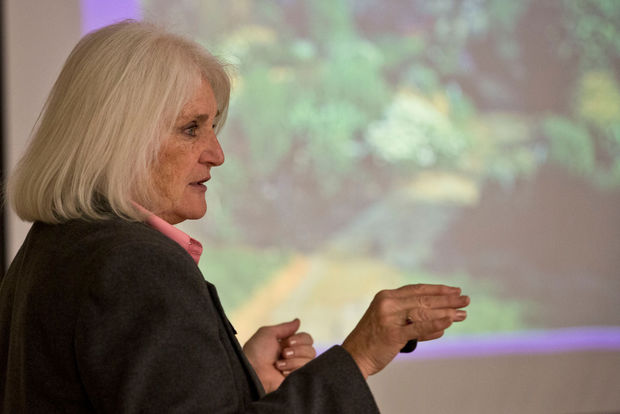
Master Gardener Explains Quirks of Utah Landscaping for Upcoming Season
Though they had to walk a path bounded by foot-high drifts of snow, some residents headed to a class were thinking more about spring and summer.
The dozen adult members attending Tuesday’s Basic Landscape Design class at Thanksgiving Point were there in hopes of either starting fresh from just dirt or updating their home’s curb appeal. Just the packet handed out in the first session of the four-week class could be worth the $40 registration price, but students are really treasuring two hours learning each week from Marilyn Simister, Utah State Extension Service master gardener.
January 14, 2016 | Source: Daily Herald | by Karissa Neely
Though they had to walk a path bounded by foot-high drifts of snow, some residents headed to a class were thinking more about spring and summer.
The dozen adult members attending Tuesday’s Basic Landscape Design class at Thanksgiving Point were there in hopes of either starting fresh from just dirt or updating their home’s curb appeal. Just the packet handed out in the first session of the four-week class could be worth the $40 registration price, but students are really treasuring two hours learning each week from Marilyn Simister, Utah State Extension Service master gardener.
Before the class starts designing, though, they’ve spent the last two sessions studying soil and plant types for Utah. Simister explained Tuesday that with the prevalence of clay soil in Utah, the regular methods of amending the soil don’t work. Gasps of surprise erupted from class members as Simister shared that to mitigate just a garden’s worth of Utah’s clay soil, they would need to add more than three feet of sand. Instead she suggested the best, most healthy way to amend Utah soil is to add organic matter.
Simister also encouraged students to really think about plant choice before purchasing. Lots of Utahns love quaking aspens, but they are a fast-growing weaker tree, that actually sends out runners — so for a low maintenance yard, they are not a good pick.
“You have to pick your plants well. The Sun, Partial Sun, and Shade guidelines are based on shorter times than most of our plants get each day here. Also, we have 100 degree differences here in temperature from summer to winter. These extreme temperature differences are hard on plants, and not all of them can survive,” Simister said.
Simister also encouraged students that are shopping to always keep in mind the size of the plant when it’s fully mature. That will help in plant choice, but will also help in plant placement. She shared pictures of various homes with poor plant placement to expand her meaning. Trees that tower over homes are not only dangerous, but also obscure the home’s appeal. Bushes can also be a problem. One picture depicted a home that looked like it had a huge dinosaur-looking mound covering its entire front yard.
She said good landscape design begins with designing for a focal point, usually the front door of a home. Plants should be larger on the outer edges of the home, and slant down in a V shape towards the focal point.
Simister’s ultimate focus is on teaching homeowners how to plan water-wise, low-maintenance landscape plans. To that end, she discouraged choosing plants that need lots of hedging or trimming and placing them in spots where they will be in the way — overhanging pathways or in the middle of the lawn. While many people, Simister included, enjoy working in the yard, most people’s lives are filled with other more pressing needs.
“Most of us don’t want to babysit our yards. You want to mow it, weed it, and then go have fun,” said Gretchen Campbell, the adult education coordinator at Thanksgiving Point.
